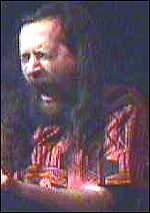
Modest Miguel: "I'm only the Gnome co-ordinator"
Sci/Tech
Gnome is no Windows dwarf
By Internet Correspondent Chris Nuttall
BBC Online Network
May 20, 1999
Windows 98 may still dominate the software shelves in computer stores, but it has been joined this month by boxed software which could loosen Microsoft's stranglehold on the market.

Modest Miguel: "I'm only the Gnome co-ordinator"
Windows is installed on 95% of the world's PCs, but its new challenger Gnome is being developed and distributed globally by more than 250 programmers supporting a free software movement.
Gnome can look like a Windows or Mac desktop, giving a friendly mouse-driven Graphical User Interface (GUI). It runs from the Linux operating system and should appeal to consumers put off by Linux's requirement for plain text commands.
Both Gnome and Linux are free to download over the Internet, but the boxed versions, with manuals, CDs and tech support by companies such as Red Hat and SuSE have gone on sale at retail outlets for less than £50 - undercutting Windows prices and their licences allowing distribution across more than one machine.
Mexican man with a mission
Gnome is the free software movement's most serious challenge yet to Bill Gates' dominance of the desktop. It is led by a modest, 26 year-old Mexican programmer, Miguel De Icaza.
"I'm only the Gnome co-ordinator," he told BBC News Online on a visit to the UK recently for a workshop and conference organised by netproject.

de Icaza: Growing Gnome
"At the release of Gnome 1.0 we had 250 people who could put changes back into the source code. This main team of developers has been assembled over the past 20 months and there are now 38 more since the 1.0 release in March."
Gnome stands for Gnu Network Object Model Environment. "It started off as a component model," says Miguel, "So you could write small modules to build bigger applications, but the GUI thing just took off."
Gnome better than KDE
There are other friendly front-ends to Linux, including the K Desktop Environment (KDE), but Gnome is quickly becoming the GUI of choice to run on top of Linux.
"I don't think KDE has a future at this point, it's not completely free yet and it's bound to a single programming language in Unix. Gnome from the very beginning has been accessible through any language. We are providing the GUI for all the languages and programmers can choose the language they like the most," says Miguel.
Gnome comes with some fully-featured applications such as a spreadsheet. A word processor is in the works, as is an e-mail program with a radically different approach to the current hierarchical structure for viewing mail.
Gnome and Linux can be installed on a PC alongside Windows as well as replacing it. Would-be users are advised to install it on a separate hard drive partition and configure their computer to have a dual-boot option so they can choose between operating systems and try Gnome out.
Linux has made great strides among Internet and network professionals. It developed into a robust operating system to challenge Windows on main servers.
This is the result of the efforts of programmers around the world working, often in their spare time, to improve on the code first developed by the Finn, Linus Torvalds.
Copyleft view of software
Miguel leans more towards the Free Software Foundation's views on this collaborative programming rather than that of the Open Source Initiative, whose chief spokesman Eric Raymond is virulently anti-Microsoft and campaigns for businesses to adopt open-source software as a cheaper and more reliable option than Microsoft's products.
The Free Software Foundation of Richard Stallman set out to develop an operating system, Gnu, whose source code would be open and which would be distributed so that it could be changed and improved on by anyone else.

Yawning Stallman: "Copyleft" not copyright
A jet-lagged Stallman explained this "copyleft", an addition to the copyright principle, at a packed lecture in London recently as part of a global tour of speaking engagements.
The terms of the copyleft agreement or GNU General Public Licence mean those using the code cannot turn it into restricted proprietary software. "Every time a copy of the software is passed on these freedoms go with it. With copyleft we actually defend the freedom for every user," he said.
"We are doing this for the freedom issues, not for fighting a specific company," says Miguel of the Gnome project.
Open Source's manual labours
One business model for making money from free software is to provide support services for running the software. Tim O'Reilly runs a successful business selling computer manuals seen as the bibles of programmers using Open Source software.
Speaking to BBC News Online at the London International Book Fair, O'Reilly said programs like Gnome could make the vital breakthrough in winning acceptance for Open Source from consumers.
But really this had already been done, he said, with consumers now buying computers in some cases just to buy books from the Amazon Website, which runs on Open Source software.
"If you look at companies like Amazon and Yahoo, Yahoo uses the FreeBSD operating system, the Apache Web server and they do most of their programming using the free Perl language," he said.
"I like to remind people that the entire Internet infrastructure was developed by the Open Source community," he added, quoting the basic TCP/IP protocols, BIND which enables domain naming and SendMail, responsible for e-mail transports.
"People have focused so much on the commercial players, like Microsoft and Netscape, that they have overlooked this enormous change that has been driven at a grass roots level by individuals who are able to collaborate at a whole new level because of the power of the Internet."
O'Reilly sees Microsoft adapting to survive in the new climate:
"Open Source will change the way Microsoft does business, it already has. But Microsoft is not going to go away. Open Source will create new players but Microsoft is big enough to be around for a long time to come."
Copyright 1999